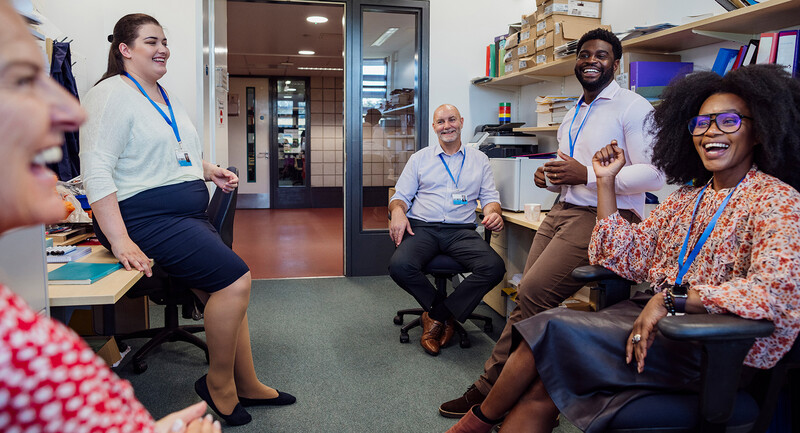Partnering with families to promote learning starts with having a mindset that all families have much to offer, Harvard educator and researcher Karen L. Mapp believes. Mapp has long promoted the idea of educators working in tandem with families and has researched the impact of family engagement on achievement. In 2003, she served as Deputy Superintendent for Family and Community Engagement for Boston Public Schools, and from 2011–2013, she was a consultant on family engagement to the U.S. Department of Education. Mapp is the author or coauthor of many books and reports, including Beyond the Bake Sale: The Essential Guide to Family-School Partnerships (New Press, 2007), the 2014 SEDL report Partners in Education: The Dual Capacity-Building Framework for Family-School Partnerships, and Powerful Partnerships: A Teacher's Guide to Engaging Families for Student Success (Scholastic, 2017).
Schools have good intentions about involving families, but families often don't become true partners in fostering students' learning. How do good intentions go awry?
We've learned over the years that good intentions aren't enough. I get invited to visit a lot of school systems, and many reach out to me that have good intentions. They truly want to have a more effective partnership with their students' families. But because the practitioners who are interested in engaging families were never trained on how to do that, they often engage in practices that aren't effective. So they become frustrated and sometimes give up. Or worse, they get it into their heads that families don't care.
This happens when no real love has been cultivated between families and school staff. Say a school tries to have an open house for families or runs a typical parent-teacher conference event. They send out emails or send notices home with the students, but because they haven't cultivated a trusting, respectful relationship with their families, the families don't come. Or sometimes families are intimidated because they've had bad experiences themselves in school. Or maybe the only phone calls home prior to this event were bad news about their child.
When districts and schools engage in more effective practices, that's when we see good intentions become high-quality family engagement. And many districts around the United States are doing fabulous, intentional work around engaging and partnering with families.
What are effective practices for engaging families?
In 2013, working in collaboration with the U.S. Department of Education, I developed a dual capacity-building framework for family-school partnerships. The framework gives guidance on what effective practice actually looks like. The most important practice to integrate into any family engagement initiative is to link that initiative to student learning and development. In the garden-variety parent involvement strategies—the sort of "random acts of parent involvement"—there's no direct connection between engagement activities and student learning.
Often when I'm working in districts or schools, I ask school leaders and their staff to identify an area in which students might be struggling academically or with social-emotional development. They'll identify some challenge—for example, strengthening literacy. So I'll ask them whether the family engagement events they have scheduled are focused on partnering with families to improve student learning in this specific area—and I get blank stares. They realize that they've scheduled the formulaic family engagement events everybody's been doing for the last 50 years, and those events are absolutely not linked to learning and student development.
We're trying to move away from the term parent involvement and switch to family engagement. Parent involvement almost always refers to individualized, passive forms of involvement.
What might a more effective open house, for instance, look like?
Some years back, I worked with a K–8 school in Boston. They made their beginning-of-the-year open house an event that would signal a change in terms of its feel and intentions. They changed the name from Open House to Family Fun Night. Teachers had the students write personal invitations to families, and the leaders scheduled time at the end of the day for teachers to make personal phone calls to parents, not using the robo-call approach, but saying, this is a night we're going to have fun and share with you some of our goals and what our kids are going to be learning.
That night, a band from Boston's Berklee College of Music played in the school. There were refreshments, and teachers wore badges that said "Welcome to our school. My name is ___." When families went into the auditorium, instead of the principal talking about the rules of the school or curriculum, the principal and staff members shared three specific goals they'd decided on, after looking at achievement data, for what all students should know and be able to do by the end of the year. There were goals around literacy and mathematics, and there was a social-emotional goal.
When the families went into the classrooms, they participated in activities teachers had designed, things that could be done at home and in the community that would support one of those goals. For example, in the early elementary classrooms, families learned how to practice sight words with children. In the 6th grade classroom, math teachers shared content connected to working with statistics. As families played board games, teachers showed them how they could translate this play into talking to their kids about mathematics concepts. The school took everyday things that families do and showed how these activities could get kids to practice important learning skills that the teachers would be going over in the classrooms.
So the families walked away from that event having learned something they could do with their children that was linked to one of those three goals—and that made families feel good. This school's teachers told me later that it made a huge difference. The families had gotten so charged up about what they could do to help their children—seeing the fruits of their labor, because the teachers would let the families know they were seeing improvements—that they wanted to learn more.
At schools that use such goal-oriented strategies, families end up really interested in being engaged. I've heard family members say, "We show up for things now because we feel like partners." These initiatives take work, but the end product is so much more exciting and fulfilling.
Stacks of research studies show that when you support family engagement in ways linked to learning and development, you see results. A few years back, a study came out that basically stated that the effectiveness of parent involvement was overrated. But what that research actually pointed out is that when schools do random parent involvement activities with no clear learning goal, that's when you don't see the effects on student outcomes.
When you look across the last 50 years of research on family engagement initiatives linked to learning, you do see results. For instance, researchers at Johns Hopkins University published a study on the effects of home visits. They found that students who got a home visit, so that the teacher and parent developed a trusting relationship and began their partnership on the right foot, not only ended up reading at or above grade level, but also had much higher attendance rates than their peers who didn't get a home visit.
It's not just grades and test scores. You also see that students whose families are engaged are the students who like school, who aren't suspended, and who graduate on time.
You've said effective family engagement needs to be developmental—to build people's capacity—and that one key is family members seeing their role in the school differently. How should their perception of their role change?
Kathy Hoover Dempsey, one of my colleagues and mentors, did wonderful work a few years back where she identified why and how families become engaged in their children's education. One thing she talks about is role construction: the way that families see their role in their children's education. A lot of times, family members—particularly those who didn't graduate from high school or have postsecondary opportunities or who are new to this country—don't feel confident in their ability to facilitate their children's learning. Kathy talks about how important it is for those families to be invited into the world of supporting children's educational and social-emotional development. They have to be invited and have opportunities to learn new things.
Many people need to be made aware of the fact that they already have skills and tools to help support their children's learning. No one has told them, "Look, you already have funds of knowledge to help support your child—we just need to cultivate that knowledge a bit more. Let's build on the actions you're already doing and see the connection between things you already know how to do and your child's development." Sort of unlocking the potential of families.
An initiative that came out of the Logan Square neighborhood in Chicago is a good example. The Logan Square Neighborhood Association collaborated with neighborhood schools to start a parent mentor program. Many of the moms who got involved didn't speak English and thought they had no talents or skills that would let them support their child's education. Through this program, parents were each assigned to a classroom (not their child's classroom), where the teacher encouraged them to help with, for instance, a few students' reading. Family members started to feel a new sense of efficacy around their ability to support not just their child, but others' children. Lo and behold, some of these parents decided, maybe I want to be a teacher myself! That developed into a grow-your-own teacher initiative in Illinois.
We often hear about the barriers families face to getting engaged. Do classroom teachers have barriers they need to overcome to partner well with families?
Teachers need training to do this work well. We really do a disservice to teachers by not providing them with the training to partner with families. A study done by MetLife a few years back found that the number one area in which teachers feel incompetent is engaging with families.
I do many speaking engagements with groups of 200–300 teachers and principals. I always ask, "How many of you have been classroom teachers?" Usually everybody raises their hand. Then I ask, "How many of you have ever received a full course, not just a workshop, on engaging and partnering with families?" And maybe one or two people raise their hands. I've done this over the last three years, and it's always the same. I don't blame teachers and principals for not knowing how to effectively engage families. We've done a horrible job providing them support to do that.
Now we're seeing more intentional efforts by districts to train their school leaders and teachers in family engagement. That's what it's going to take—that and robust preservice work. Preservice is where we need to start. If new practitioners understand that family engagement is a key component to their being effective teachers, that will carry with them throughout their careers.
I'm working hard now on trying to get states to include some proficiency standards for teachers on family engagement. For new teachers, proficiency in family engagement would be part of the licensure criteria; for practicing teachers, it would be part of their evaluation standards. The Massachusetts Educator Evaluator Standards for practicing teachers, for instance, include family engagement standards. Districts are using those standards to figure out the kind of training they'll develop for their practitioners. But we also need standards around family engagement for new teachers, because that will cause teacher training institutions and certification programs to be more rigorous about training for family engagement.
It's also important to have district teams that support this work in the schools and to train teachers on more effective engagement practices. This is what I mean by family engagement being systemic throughout a district. When I was Deputy Superintendent for Family and Community Engagement in Boston in 2003, that was one of the few districts in the United States in which a staff member who oversaw family and community engagement was part of the superintendent's leadership team. There were a handful of such positions back in 2003; now more than 150 districts have family engagement practitioners at the central office level who oversee the work at the district level.
What are some things a teacher might do to start repurposing her practice in this way?
The work has to start with self-reflection. When I work with teachers, the first thing we do is examine their core beliefs around family engagement. I ask questions like, "Do you believe all families have hopes and dreams for their children?" "Do you believe families can be your partners?" "Should you play a key role in starting those partnerships?" We ask teachers to tell us about the families they serve, including what talents they've identified in caregivers. A lot of times, those are hard questions for people to answer. If someone hasn't examined his or her biases, those biases can get in the way of trying to reshape practice.
Some teachers have revealed that they didn't think certain families had the capacity to support their children's education. The "certain families" changes depending on the context, but typically it's families who come from poverty, who don't speak English, or who've experienced some sort of trauma. In some cases, teachers will admit to me that they have racial biases they haven't examined, or that they've assumed—particularly with families coming from poor communities—that families don't want to be involved or don't care.
Some years back, teachers from a new school in the Boston area came to talk with a class of my graduate students. One teacher said she thought her job was to inoculate some students against their families and their community. I think this teacher thought that she had good intentions. She wanted to lift these kids up. But clearly, she had a bias about that community, thinking that everything in it was negative.
Once teachers have had conversations about biases and assumptions, they need to start letting parents in on what it is they're trying to accomplish. I don't know how many times I've had families tell me, "Dr. Mapp, the school's not telling us what our kids should know and be able to do by the end of the year. We want to know."
I was in a session in Texas with Latino parents, talking with them through a translator, and the parents began to weep and say things like, "Please tell the teachers that we want to be engaged. We want to know how we can support our children's learning." They were very passionate. They actually told me, "We think the teachers think we don't care because we can't come to the school. We can't come because our jobs prevent us."
We have to get away from thinking that it all happens at the school. Here's one example of how a school changed their practice: In an Iowa district, many parents worked at the meat packing plant. So the school worked with the supervisors at the plant to do their engagement activities there when parents went on break.
What are three key things any caregiver should know about their child's school and school work?
First, they need to know they are an integral part of their children's development. That regardless of their past education experience, regardless of their socioeconomic standing, they are their child's first teacher. And they are already doing things that support their children's learning, things that can be enhanced through partnership with the school.
Second, they should know that families have knowledge about their children that we, as educators, need. Teachers who've been working in real partnerships tell me, "Boy, the knowledge I get from families about what their child likes, things they've noticed about their child, really helps me differentiate my instruction."
Third, families need to know that they shouldn't be afraid to reach out to their child's teacher and school. We should respectfully tell family members to reach out and say, "I really want to know how to best support my child."
What about the unspoken rules schools operate by—things like the fact that it's OK to request a certain teacher for your child? Is it helpful for teachers to clue parents into those kinds of things?
What's most effective isn't teachers giving only a few parents advice. It's a more concerted effort. For example, when Andres Alonso was superintendent of Baltimore City Public Schools, he contracted with five community organizing groups in Baltimore. He realized that these were important and knowledgeable constituents, so he partnered with them to coordinate parent leadership trainings around the city, explaining to large groups of parents the basics of how schools are run, giving parents insider knowledge. Teachers did some of these trainings. They'd talk to parents about things like how the school budget works, district policies around bilingual education, or what a whole-school reform strategy looks like. So it wasn't just teachers doing little things or saying, "Hey, you can do this for your child." It was about creating a community in Baltimore that supports the schools.
Family-school partnership is better if it's happening systemwide, with larger groups. We want to build partnerships between families and teachers that are about lifting up all boats, not just a few.
Editor's Note: This interview has been edited for space and clarity.
Books by Karen Mapp
Karen Mapp's books explore many aspects of how to join forces with families in ways that boost learning:
Beyond the Bake Sale: The Essential Guide to Family-School Partnerships (New Press, 2007). Coauthored with Anne T. Henderson, Vivian R. Johnson, and Don Davies
A Match on Dry Grass: Community Organizing as a Catalyst for School Reform (Oxford University Press, 2011). Coauthored with Mark Warren
A 2014 report by SEDL: Partners in Education: The Dual Capacity-Building Framework for Family-School Partnerships
Powerful Partnerships: A Teacher's Guide to Engaging Families for Student Success (Scholastic, 2017). Coauthored with Ilene Carver and Jessica Lander








